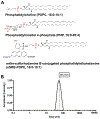Characterization of Protein-Phospholipid/Membrane Interactions Using a "Membrane-on-a-Chip" Microfluidic System
- PMID: 33481237
- PMCID: PMC8212032
- DOI: 10.1007/978-1-0716-1142-5_10
Characterization of Protein-Phospholipid/Membrane Interactions Using a "Membrane-on-a-Chip" Microfluidic System
Abstract
It is now clear that organelles of a mammalian cell can be distinguished by phospholipid profiles, both as ratios of common phospholipids and by the absence or presence of certain phospholipids. Organelle-specific phospholipids can be used to provide a specific shape and fluidity to the membrane and/or used to recruit and/or traffic proteins to the appropriate subcellular location and to restrict protein function to this location. Studying the interactions of proteins with specific phospholipids using soluble derivatives in isolation does not always provide useful information because the context in which the headgroups are presented almost always matters. Our laboratory has shown this circumstance to be the case for a viral protein binding to phosphoinositides in solution and in membranes. The system we have developed to study protein-phospholipid interactions in the context of a membrane benefits from the creation of tailored membranes in a channel of a microfluidic device, with a fluorescent lipid in the membrane serving as an indirect reporter of protein binding. This system is amenable to the study of myriad interactions occurring at a membrane surface as long as a net change in surface charge occurs in response to the binding event of interest.
Keywords: Fluorescence; Label-free; Microfluidics; Phosphatidylinositol 4-phosphate; Phosphoinositides; Pleckstrin Homology domain; Supported lipid bilayer; pH modulation.
Figures




References
MeSH terms
Substances
Grants and funding
LinkOut - more resources
Full Text Sources
Other Literature Sources

